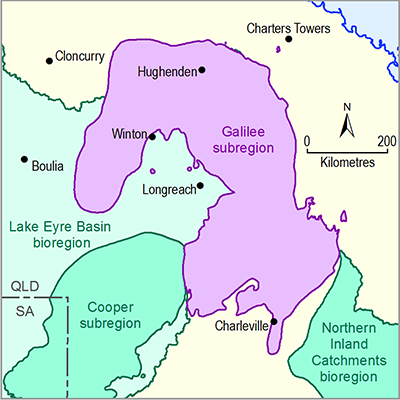- Home
- Assessments
- Bioregional Assessment Program
- Galilee subregion
- 2.7 Receptor impact modelling for the Galilee subregion
- 2.7.5 'Floodplain, terrestrial groundwater-dependent ecosystem' landscape group
Summary
The ‘Floodplain, terrestrial groundwater-dependent ecosystem (GDE)’ landscape group contains two landscape classes within the zone of potential hydrological change of the Galilee subregion: ‘Terrestrial GDE, remnant vegetation’ and ‘Terrestrial GDE’. The zone contains 2358 km2 of ‘Terrestrial GDE, remnant vegetation’ compared to 75.2 km2 of ‘Terrestrial GDE’. The vegetation in this landscape group depends on the subsurface expression of groundwater on a permanent or intermittent basis to maintain growth or avoid water stress and adverse impacts on condition. The landscape classification does not distinguish between artesian and non-artesian groundwater sources.
The physical environment of the ‘Floodplain, terrestrial GDE’ landscape group is described here along with descriptions of vegetation assemblages, threatened flora and fauna and threatened ecological communities. The water requirements and the degree of groundwater dependency of the vegetation focus here on rooting depth and depth to watertable. It identifies two variables – groundwater and surface water – as the key hydrological elements. These variables influence trees that support a woodland community, and create local conditions and a microclimate (i.e. shade, leaf litter and soil moisture) that favours mesic vegetation and suppresses xeric vegetation. Qualitative analyses of the four signed digraph models developed generally indicate a negative or ambiguous response prediction for all biological variables within the floodplain ecosystem.
Key ecological relationships identified through the qualitative mathematical modelling of the ‘Floodplain, terrestrial GDE’ landscape group were formalised into a receptor impact model that related the response in annual foliage cover to changes in maximum drawdown (dmaxRef) and overbank flood events (EventsR2.0). The model indicates that the experts’ opinion provides evidence that foliage cover may decrease as groundwater drawdown increases due to additional coal resource development. There is, however, considerable uncertainty in these predictions across both the short-assessment period (2013-2042) and the long-assessment period (2073-2102).
The receptor impact modelling also indicates that there is evidence in the experts’ responses for overbank flood events (Events R2.0) to have a major quadratic effect on percent foliage cover. The frequency of overbank flood events will generally have a positive effect on average percent foliage cover, unless that frequency becomes too high. When values of Events R2.0 exceed 1 there will be a negative effect on percent foliage cover.

Product Finalisation date
- 2.7.1 Methods
- 2.7.2 Overview
- 2.7.2.1 Introduction
- 2.7.2.2 Potentially impacted landscape groups
- 2.7.2.3 'Springs' landscape group
- 2.7.2.4 Streams landscape groups
- 2.7.2.5 'Floodplain, terrestrial GDE' landscape group
- 2.7.2.6 'Non-floodplain, terrestrial GDE' landscape group
- 2.7.2.7 Outline of content in the following landscape group sections
- References
- Datasets
- 2.7.3 'Springs' landscape group
- 2.7.4 Streams landscape groups
- 2.7.5 'Floodplain, terrestrial groundwater-dependent ecosystem' landscape group
- 2.7.6 'Non-floodplain, terrestrial groundwater-dependent ecosystem' landscape group
- 2.7.7 Limitations and gaps
- Citation
- Acknowledgements
- Contributors to the Technical Programme
- About this technical product
